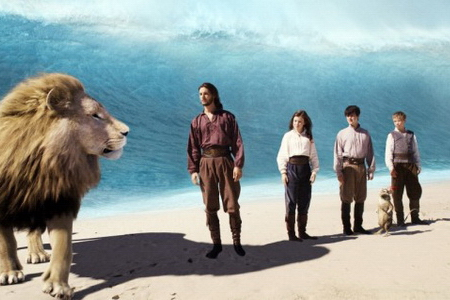| |
 |
 |
 |
| The story so far... |
 |
| You're currently on our features and projects pages, with material ranging from the satirical to the theological. For more features, click here. |
| |
|
|
 |
 |
 |
| Dawn Treader leaves aftertaste of plastic |
 |
Steve Tomkins went to see new film of CS Lewis's The Voyage of the Dawn Treader, but like Edmund and Lucy, this may be his last visit to Narnia... on the big screen, at least.
I believe this is where I lose faith in the Narnia films. As someone who loved the books as a child and again as a parent, I was all set to hate the films from the off, but The Lion, the Witch and the Wardrobe completely won over my scepticism with its visual imagination, fine performances and faithfulness to the heart of the book. Prince Caspian was disappointingly dull, but then it is the poorest of the books, so that was forgivable.
But there is no excuse for The Voyage of the Dawn Treader not to delight. It is a wonderfully inventive odyssey story, packed with unforgettable scenes. The eponymous dragon-shaped galleon takes our heroes on an expedition to find the seven missing lords of Narnia, and on the way they face sea monsters, waters that turn people into gold, gold that turns people into dragons, and invisible giants that turn out to be dwarves.
What's not to like? Fox, the new owners of the franchise, have splashed out on the CGI, making for impressive monsters and talking beasts, but the film lacks anything by way of characters that engage the audience and make us believe or care, without which all the hi tech jiggery pokery leaves a strong taste of plastic in the mouth.
Like the Harry Potter series, Narnia lays a great weight on the shoulders of child actors, with the added burden that the Narnian crew are unhelpfully virtuous. The supporting adults are almost all Australians and New Zealanders doing English accents with varying degrees of success, from the Gwyneth Paltrow level to the Dick van Dyke.
And when the characters fail to carry the story, other niggles start to rankle more, like the film's over-reliance on people explaining to no one in particular what's happening on the screen, and on strings as a substitute for caring about characters.
The film also fails to get to grips with the centrepiece of the book, where Aslan turns the infidel Eustace from a dragon back into a human, a parable for religious conversion. Eustace's dragonishness, refusal to believe and general badness have made him miserable, and Aslan has to claw off his dragon flesh, only to find underneath another layer of the same. So the painful process has to begin again and again. It's compelling piece of storytelling that perfectly captures theology in a way that makes sense on a child's level. On the screen however, there is little more to it than Aslan magicking him back to his proper form.
Faith is very much present in the film, to be sure, but while the novels make CS Lewis's faith beguiling and irresistible, the faith of the film is a lot less attractive. We are repeatedly pressed with the need to believe in something nice, no matter how implausible. One has to believe in Aslan's country at the edge of the world, because "Without belief, what do we have?" "You just have to faith in these things."
Set against this is the unbelieving Eustace, who loves books of "information" and prefers logic to make believe. In other words, the film plays out the contemporary spat between "religion" and "science", tipping the playing field unwinnably against science.
But Lewis's whole argument was that, given a fair chance, both logic and myth, both factual investigation and the urge to believe, will lead us to the same truth. The film asks us to choose faith over facts. Watching it, and unconvinced by either its insipid heroes or their dubious credo, I rather found myself taking Eustace's side. And I think CS Lewis would have done so too. |
|
|
|
|
|
|


